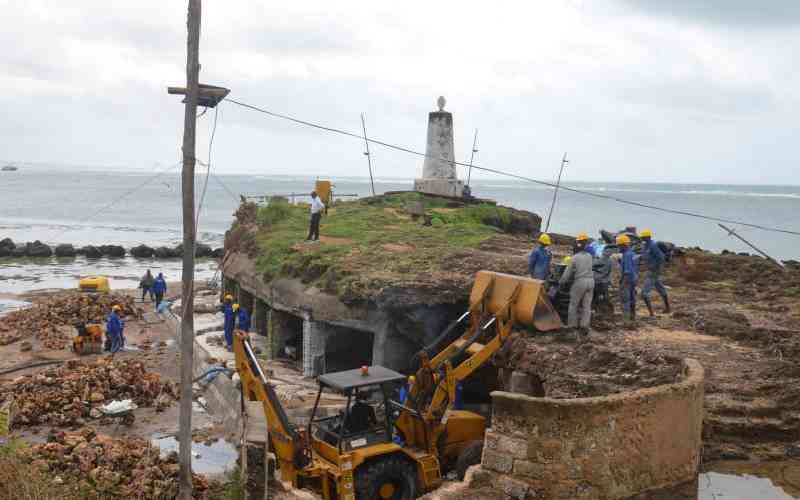By LILLIAN ALUANGA-DELVAUX
KITUI; KENYA: Trucks laden with building materials drove in and out of the construction site tucked at the foot of a long and winding dusty trail.
All day earthmovers, excavators and bulldozers heaved, roared and groaned under the weight of soil, sand and gravel, as what promised to boost water supply for residents of Kitui County began to take shape.
At the end of each day, weary workers, pockets lined with daily wages, would troop to the nearby Pejos pub to quench their thirst. Next to the pub were an eatery and the ‘Wa Lydiana’ shop, where groceries flew off the shelves, spiking demand that rose with the number of people working at the site.
Eerie silence
Fast forward, two years later, and all that remains where what was to be the Umaa Dam is an eerie silence, broken by chirping birds and rustling bushes, as lizards scurry for cover. Staff quarters that would have housed dozens are now a ghost town with nothing but weeds and grass occupying the compound. Steel wires, reinforcement and anchor bars that would have held concrete in place along sections of the dam lie on the ground, some still tied in bundles. Standing forlornly in one corner of the 18-acre piece of land are earthmovers that appear planted into the ground. The rust stains and grass sprouting around their wheels bear proof of how much elements of weather and months of disuse have conspired against the machines.
“The engines are regularly started and kept running for some time to keep them functional. There is also someone who watches over the equipment and other materials left behind,” says a caretaker at the site, as he walks over to the makeshift tower where a guard is stationed.
The caretaker walks around the site pointing out half built structures that would have formed the wall and spillways on the dam. Had it been completed as planned the dam, built along the Nzeu River, would have served more than 25,000 people. But its construction was steeped in controversy over alleged inflated cost, resulting in the halting of the multimillion shilling project in 2010.
At some point it was alleged that the cost of building the dam was spiked from Sh820 million to Sh1.4 billion and that little progress had been made on the ground despite millions of shillings being pumped into the project.
That saw a parliamentary committee set up to investigate the matter, with then Water Minister and Kitui Central MP Charity Ngilu blaming the saga on political rivalry. Mrs Ngilu is now Land, Housing and Urban Development Cabinet Secretary.
But for locals, the stalling of the project goes far beyond political power games and corruption allegations to the stifled economy many had hoped would thrive.
“If the dam was completed we could have used the water for irrigation. Now the heavy rains have come and gone, carrying away most of our crop. The water we use from Masinga Dam isn’t enough and its supply is unreliable. One can spend half the day in search of water, particularly during the dry season, and we were hoping this would ease with supply from the dam,” says Mutanu Peter, a resident of Kyangwithya East location, Kitui Central constituency.
But it is not just the poor water supply that irks Peter. He also blames the crumbling of his investments at the Makutano market on the stalled project and wonders when and if he will ever recover. The pub and grocery store are part of residential and commercial stalls he was renting out at Sh1,000 a month. That was when business was good, fetching him about Sh10,000 a month. Now most rooms are vacant after tenants moved out of the once busy market centre that stands closest to the site where the dam would have stood. “I hope the Government will revive the project because this will help me recover some money,” he says.
Besides the money Peter is optimistic that building a dam in the area would help them irrigate farms and save residents long trips to Nzunguni market for their supply of fresh vegetables.
Better than nothing
Stay informed. Subscribe to our newsletter
At the Nzunguni market centre one blistering afternoon, a group of youth sits idly outside one of the few open shops, chewing khat.
“A day’s work at the site earned one Sh200. It wasn’t much but it was better than having nothing at all because jobs are hard to come by,” says David Kyeli. Anotherone who appears to be in his late 20s joins Kyeli. He is drunk and lights up at mention of the dam. “It would have helped. Maybe we would even have a small project to generate electricity. But now there is nothing, nothing at all,” he mutters, as he staggers away.
Kyeli points to a water kiosk at the market centre that was built around the same time the project was underway. “There has never been a drop of water from it since it was built. Perhaps things will change if the dam is completed,” he says.
Benefits
Dams have a range of economic and social benefits, including water supply, irrigation, flood control, water storage and electricity generation. But they are also deemed expensive to construct, with environmentalists pointing to their destruction of natural environment, disruption of natural water courses and displacement of populations, as negative effects. It is estimated that more than 900 dams and water pans have been constructed in the country in the past eight years.
But for many like Mutanu and Kyeli, debates on merits and demerits of dams and estimates from international organisations mean little at this time. Theirs is only one dream. To see machines at the site roar back to life and with it the promise of an improved water supply and thriving economy fulfilled.
 The Standard Group Plc is a
multi-media organization with investments in media platforms spanning newspaper
print operations, television, radio broadcasting, digital and online services. The
Standard Group is recognized as a leading multi-media house in Kenya with a key
influence in matters of national and international interest.
The Standard Group Plc is a
multi-media organization with investments in media platforms spanning newspaper
print operations, television, radio broadcasting, digital and online services. The
Standard Group is recognized as a leading multi-media house in Kenya with a key
influence in matters of national and international interest.
 The Standard Group Plc is a
multi-media organization with investments in media platforms spanning newspaper
print operations, television, radio broadcasting, digital and online services. The
Standard Group is recognized as a leading multi-media house in Kenya with a key
influence in matters of national and international interest.
The Standard Group Plc is a
multi-media organization with investments in media platforms spanning newspaper
print operations, television, radio broadcasting, digital and online services. The
Standard Group is recognized as a leading multi-media house in Kenya with a key
influence in matters of national and international interest.








